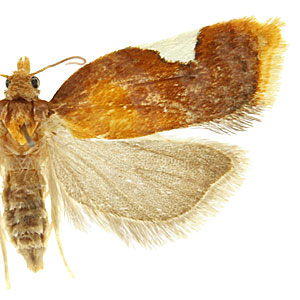Adult Recognition

FWL: 5.5-8.0 mm
Adults are yellowish brown to orange or red with a conspicuous, white, semitriangular costal patch. Males lack a forewing costal fold. Male genitalia are characterized by a reduced uncus and elongate valva with an apical membranous lobe. Female genitalia are characterized by a small corpus bursae with a single scobinate signum.
Some (aberrant) individuals of Archips argyrospila can appear similar, although the costal patch is usually trapezoidal rather than triangular in A. argyrospila and males have a forewing costal fold. A genitalic dissection can easily separate A. holmiana from A. argyrospila.
Acleris holmiana was collected in large numbers as a non-target during Epiphyas postvittana pheromone trap surveys conducted in Washington.
Larval Morphology

Last instar larvae are yellowish to pale green. The head is light brown to reddish brown with black posterior shading. The prothoracic shield is black or dark brown with black posterolateral margins. An anal comb is present.
Biology

In North America, Acleris holmiana completes two, and possibly three, generations per year. Adults are present in May and again in June and July.
Larvae create a shelter by webbing together two leaves at their margins. Pupation occurs in the larval shelter. Overwintering occurs in the egg stage.
Host plants
This species is a minor pest of fruit trees (Rosaceae) in Europe. In addition to Rosaceae, it has been recorded feeding on buffalobur nightshade (Solanaceae) in Washington.
| Family | Genus/species | Common name |
| Rosaceae | Crataegus L. | hawthorn |
| Rosaceae | Cydonia Mill. | cydonia |
| Rosaceae | Malus domestica Borkh. | apple |
| Rosaceae | Malus Mill. | apple |
| Rosaceae | Malus sylvestris (L.) Mill. | European crab apple |
| Rosaceae | Prunus L. | [various] |
| Rosaceae | Pyrus L. | pear |
| Rosaceae | Rosa L. | rose |
| Rosaceae | Rubus L. | blackberry |
| Rosaceae | Sorbus aucuparia L. | European mountain ash |
| Solanaceae | Solanum rostratum Dunal | buffalobur nightshade |
Distribution

A native of Europe and Asia Minor, Acleris holmiana was discovered in North America (British Columbia) in 1977. It was first detected in the U.S. (Washington) in 1994. It has apparently not spread outside of the Pacific Northwest.
References

Bradley, J. D., W. G. Tremewan and A. Smith. 1973. British Tortricoid Moths - Cochylidae and Tortricidae: Tortricinae. The Ray Society, London, England.
Mutuura, A. and E. Munroe. 1978. An old world leaf roller potentially injurious to Rosaceae, newly discovered in British Columbia, Croesia holmiana (Lepidoptera: Tortricidae). The Canadian Entomologist. 110: 641-646.
Obraztsov, N. S. 1963. Some North American moths of the genus Acleris. Proceedings of the United States National Museum. 114: 213-270.
Razowski, J. 2002. Tortricidae of Europe, Vol. 1, Tortricinae and Chlidanotinae. Frantisek Slamka, Slovakia. 247 pp.


